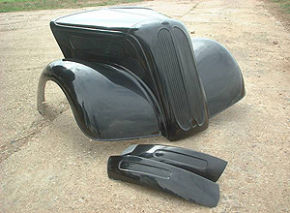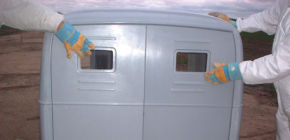

What is GRP (Glass Reinforced Plastics)
GRP stands for 'Glassfibre Reinforced Plastics', also referred to as 'Fibreglass', Composite Plastics. It is an amazingly versatile material, and one that is little understood in industry, but which has truly immense potential across a wide spectrum of applications.
Its vast range of properties can be confusing to the uninitiated. It is a 'plastic', but it displays few of the disadvantages of conventional 'thermoplastics' in everyday use.
For instance, it will not melt, but will burn in a similar way to wood, but can be easily and cheaply made fire retardant. It is very strong - seven times the flexural strength of steel - yet very lightweight with the tremendous energy absorption properties which have made it a common material for racing cars and boats. Its finish is achieved in contact with a mould surface and takes on the precise texture of that mould. The finish can be anything from the highest showroom gloss to the texture of cast iron, stone, or the finest grained wood. Colour choices are infinite, from the complete ranges of BS, RAL and Pantone to translucent, metallic and 'glitter' effects.
However, GRP is a moulded product which requires some sort of former or tool from which it is moulded. In its simplest and most common form, known as 'hand-lay', the fibreglass mould is first prepared with a release wax, similar to car polish. The colour is then applied by brush or spray to the mould face as a 'gelcoat', which is a thickened, coloured resin. This is allowed to 'cure' for about 20-30 minutes, and is followed by layers of glassfibre mat together with the fibre glass resin. This can be put down or 'layed-up' by brush, or even sprayed using special machines which 'chop' continuous filaments of glassfibre into specified lengths and blow these down in a spray of resin. The product is then formed by the hardening of the resin and glass matrix into an integrated moulding.
The hardening agent is called the 'catalyst' which is mixed into the resin at precise formulations causing 'exothermic' heat to build up in the moulding. This cures the resin within a normal working time of 20-30 minutes. The moulding can then be lifted from the mould to be trimmed of excess material and finished as required.
That is the basic technique. But over the years new GRP technology has allowed much more sophisticated systems to offer far greater properties. Closed moulding now offers 'good-both-sides' mouldings, and the use of 'core' materials between the glassfibre laminations has added immeasurably to strength and durability. Techniques using translucent laminates can now 'encapsulate' graphics within the laminate both for protection and for backlit displays. Special masking techniques make multi-coloured and multi-textured moulding possible.


GRP stands for 'Glassfibre Reinforced Plastics', also referred to as 'Fibreglass', Composite Plastics. It is an amazingly versatile material, and one that is little understood in industry, but which has truly immense potential across a wide spectrum of applications.
Its vast range of properties can be confusing to the uninitiated. It is a 'plastic', but it displays few of the disadvantages of conventional 'thermoplastics' in everyday use.
For instance, it will not melt, but will burn in a similar way to wood, but can be easily and cheaply made fire retardant. It is very strong - seven times the flexural strength of steel - yet very lightweight with the tremendous energy absorption properties which have made it a common material for racing cars and boats. Its finish is achieved in contact with a mould surface and takes on the precise texture of that mould. The finish can be anything from the highest showroom gloss to the texture of cast iron, stone, or the finest grained wood. Colour choices are infinite, from the complete ranges of BS, RAL and Pantone to translucent, metallic and 'glitter' effects.
However, GRP is a moulded product which requires some sort of former or tool from which it is moulded. In its simplest and most common form, known as 'hand-lay', the fibreglass mould is first prepared with a release wax, similar to car polish. The colour is then applied by brush or spray to the mould face as a 'gelcoat', which is a thickened, coloured resin. This is allowed to 'cure' for about 20-30 minutes, and is followed by layers of glassfibre mat together with the fibre glass resin. This can be put down or 'layed-up' by brush, or even sprayed using special machines which 'chop' continuous filaments of glassfibre into specified lengths and blow these down in a spray of resin. The product is then formed by the hardening of the resin and glass matrix into an integrated moulding.
The hardening agent is called the 'catalyst' which is mixed into the resin at precise formulations causing 'exothermic' heat to build up in the moulding. This cures the resin within a normal working time of 20-30 minutes. The moulding can then be lifted from the mould to be trimmed of excess material and finished as required.
That is the basic technique. But over the years new GRP technology has allowed much more sophisticated systems to offer far greater properties. Closed moulding now offers 'good-both-sides' mouldings, and the use of 'core' materials between the glassfibre laminations has added immeasurably to strength and durability. Techniques using translucent laminates can now 'encapsulate' graphics within the laminate both for protection and for backlit displays. Special masking techniques make multi-coloured and multi-textured moulding possible.



